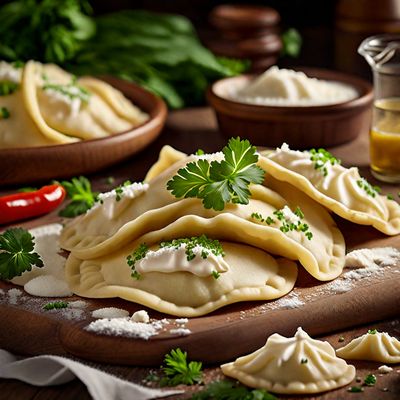
Ingredient
Soft-ripened cheese veined with blue mould (blue bavarian, blue de graven type )
Velvety Blue Delight
Soft-ripened cheese veined with blue mould is characterized by its creamy and velvety texture, with a rich and tangy flavor that intensifies as it ages. The blue veining throughout the cheese adds a pleasant sharpness, while the rind provides a delicate earthy note. Its appearance showcases a pale ivory interior with marbled blue veins, encased in a bloomy white rind.
Origins and history
Soft-ripened cheese veined with blue mould has a rich history that dates back to the Middle Ages in Europe. It is believed to have originated in France, with the famous Roquefort cheese being one of the earliest examples. Over time, this cheese has gained popularity worldwide and is now produced in various countries. Its unique flavor and texture have made it a beloved ingredient in both traditional and modern cuisines.
Nutritional information
Soft-ripened cheese veined with blue mould is a good source of protein, calcium, and vitamin B12. It is also relatively high in fat and sodium, so moderation is key. A 1-ounce serving of this cheese provides approximately 100-120 calories.
Allergens
Soft-ripened cheese veined with blue mould may contain allergens such as milk and penicillium mold, which can cause allergic reactions in sensitive individuals.
How to select
When selecting soft-ripened cheese veined with blue mould, look for a cheese that is evenly veined with blue mold throughout, without any signs of excessive mold growth or discoloration. The cheese should have a creamy texture and a slightly firm rind. Avoid cheeses with an ammonia-like smell, as it may indicate over-ripeness.
Storage recommendations
To maintain the freshness and quality of soft-ripened cheese veined with blue mould, it is best stored in the refrigerator. Keep it wrapped in wax or parchment paper to allow it to breathe and prevent moisture buildup. Avoid storing it in airtight containers, as it can cause the cheese to become overly moist and lose its texture.
How to produce
Soft-ripened cheese veined with blue mould can be produced by experienced cheesemakers who follow specific aging and ripening processes. However, it requires specialized equipment and controlled environments, making it challenging for amateurs to produce at home.
Preparation tips
Soft-ripened cheese veined with blue mould is a versatile ingredient that can be enjoyed in various ways. It can be served on a cheese board with fruits and nuts, crumbled over salads for added flavor and texture, melted into creamy sauces for pasta dishes, or even incorporated into desserts like cheesecakes or tarts for a unique twist.
Culinary uses
Soft-ripened cheese veined with blue mould is commonly used in dishes such as salads, pasta, risottos, and sandwiches. It pairs well with fruits like pears and apples, as well as nuts such as walnuts and pecans. It is also a popular choice for cheese platters and charcuterie boards.
Availability
Soft-ripened cheese veined with blue mould is widely available in specialty cheese shops, gourmet grocery stores, and some supermarkets. It is commonly produced in countries like France, Italy, Spain, and the United States.
More ingredients from this category

Cheese, bavarian blue
The Bold and Creamy Delight: Exploring Bavarian Blue Cheese

Cheese, blue castello
Velvety Blue Indulgence

Cheese, cashel blue
"The Creamy Delight: Unveiling the Allure of Cashel Blue Cheese"

Cheese, blue de graven
The Bold and Beautiful: Exploring the World of Blue de Graven Cheese
